
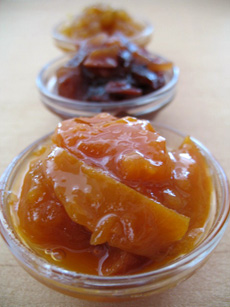
Three conserves from Frog Hollow Farm, which grows its own organic fruit. Frog Hollow Farm photos by Melody Lan.
|
STEPHANIE ZONIS writes about organic issues, focusing on a different organic food each month.
|
|
August 2007
|
 |
In A Jam
The Best Organic Jams & Preserves
Click here to read other months’ Organic Matter columns
CAPSULE REPORT: Organic jams and preserves may be wholesome and delicious, but they are name-challenged. Because the FDA’s Standard of Identity for jelly and jam specify a higher level of sugar than many organic producers wish to put in their products, an organic product often bears a different name—fruit spread or conserve, for example, terms that are not held to a Standard of Identity. Even though the product may be a jam and not a traditional fruit spread or conserve, the manufacturer has had to choose a name that most people will recognize, and that conveys some sense of what the product is. Seventeen organic jams and preserves were reviewed, including kosher entries.
My name is Stephanie Zonis, and welcome to Organic Matter for August, 2007.
Overview
Although the earliest known example of a recipe for preserved fruits dates from the first century B.C.E., it is probable that preserves had been around for much longer. Most sources accept the idea that extending the life of fruits by cooking them with a sweetener originated in the Middle East, where cane sugar grew naturally. It’s likely that Crusaders returning to Europe introduced fruit preserves there, and by the late Middle Ages preserves were popular in Europe. From there, preserves spread to the New World when European settlers brought their cooking practices with them, and jam was being made in the Colonies before the end of the 17th century, perhaps 100 years before the United States was born. Fruit preserves have continually increased in popularity since those days, and retail sales of jams, jellies, preserves, fruit spreads and related products exceed $630 million per year, according to the International Jelly and Preserve Association. Organic fruit spreads account for just a small fraction of annual preserve sales, but their popularity is increasing.
Preserves: Overview
All types of fruit preserves are generally made from fruit, sugar and pectin (some very high-end products don’t use pectin because of the high concentration of fruit). These days, in addition to or in place of sugar, many manufacturers use corn syrup or high fructose corn syrup, as both are cheaper sweeteners. Pectin is a type of fiber that occurs naturally in the cell walls of most fruits. When the fruit is heated in water and the correct quantities of both sugar and acid are present, pectin will form a colloidal solution that gels, or thickens, as it cools. Pectin can be added to a fruit preserve in powder or liquid form if the fruit is too low in naturally-occurring pectin; alternatively, the fruit low in pectin can be combined in the preserve with other fruit(s) that are naturally higher in pectin.
Do you know the differences between the various types of fruit spreads?
- A jelly is made solely from the juice of a fruit. Typically, jellies are the stiffest type of fruit preserves.
- A jam is a thick purée, made from fruit pulp or crushed or mashed fruit.
- Preserves are similar to jams, but they consist of chunks of fruit (or even whole fruits) in thickened syrup.
- Chutney is a kind of preserve of fruits (and/or vegetables) cooked with sugar, vinegar and spices.
- Marmalades are preserves, too, but they’re usually citrus-based.
- A conserve is a jam made from a blend of fruits. Conserves usually contain some form of citrus, as well as nuts and/or raisins; many contain alcohol, too.
- Fruit butter is a thick, smooth mixture, most often flavored with spices.
|
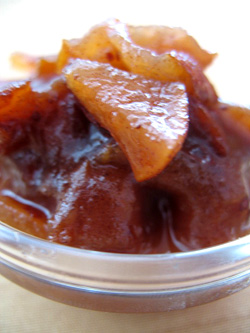
Asian Pear Chutney from Frog Hollow Farm. |
- Fruit spreads commonly include fruit juice concentrates or low-calorie sweeteners (such as aspartame and sucralose), replacing part or all of the sugar.
Read more about these, plus curds, fruit butters and other products, in our Glossary of Jam, Jelly & Related Terms.
Organic Preserves: The Difference
The definitions above are traditional—that is, they’ve been historically correct. But organics complicate the picture somewhat. According to Jeannie Milewski of the Juice Products Association (JPA), the FDA’s Standard of Identity for both jam and jelly, which have existed since 1940, require that a minimum of 45 to 47 parts fruit ingredient (depending on the fruit used), by weight, be added to each 55 parts, by weight, of saccharine ingredient (sugar or other sweetener). The fruit and sweetener mixture, along with other optional ingredients, must be concentrated to achieve 65% soluble solids (Milewski is a Section Coordinator for the JPA, the umbrella organization for the International Jelly and Preserve Association and other groups.).
If you’re a manufacturer of organic preserves, however, you may find the percentage of sugar too high for your tastes or the palates of your consumers. These 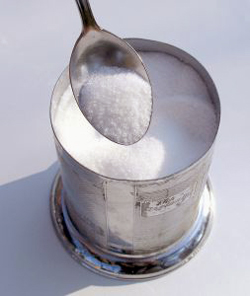 manufacturers are proud of the flavor of their fruit (which is often organically grown) and prefer to let that taste be the predominant one, so they use less sugar than what is required by the FDA (I have not yet run across a manufacturer of organic fruit spreads who uses corn sweeteners, and I’d like that trend to continue). Therefore, they’re not allowed to call their product either. For this reason, you’ll often see organic preserves labeled as “fruit spreads” or “conserves.” These products don’t necessarily adhere to the traditional definition of either fruit spreads or conserves, but their manufacturers have to find a name for the product that most people will recognize and that conveys some sense of what the product is. Some organic preserves also lack pectin, which means they may have a thinner consistency than those you’re accustomed to (depending upon the fruit[s] used); you must judge whether or not you find that acceptable. Photo of sugar by Sanja Genero | SXC. manufacturers are proud of the flavor of their fruit (which is often organically grown) and prefer to let that taste be the predominant one, so they use less sugar than what is required by the FDA (I have not yet run across a manufacturer of organic fruit spreads who uses corn sweeteners, and I’d like that trend to continue). Therefore, they’re not allowed to call their product either. For this reason, you’ll often see organic preserves labeled as “fruit spreads” or “conserves.” These products don’t necessarily adhere to the traditional definition of either fruit spreads or conserves, but their manufacturers have to find a name for the product that most people will recognize and that conveys some sense of what the product is. Some organic preserves also lack pectin, which means they may have a thinner consistency than those you’re accustomed to (depending upon the fruit[s] used); you must judge whether or not you find that acceptable. Photo of sugar by Sanja Genero | SXC.
As a consumer, you need to decide how important it is to see that green and white USDA certified organic sticker on a product. Regular readers of this column know that I’m not the world’s biggest fan of the USDA. Organic certification is not necessarily a negative, but the rules for organic products in the U.S. are so weak and lax, and arranged for large-scale megacorporations to such a degree, that small-scale producers of products more in the genuine spirit of the organic movement can get crowded out of the picture. Organic certification is a lengthy, expensive process, with an insane amount of paperwork, and a good number of small manufacturers simply can’t afford it, even though their products may be produced completely according to organic regulations. It’s something of a vicious circle; if they could get big enough, they could afford organic certification. But one of the chief ways to get to that economic plateau is by having that USDA certified organic sticker on your product.
Some preserve makers opt out of this scene entirely. The June Taylor Company in California uses organically- and sustainably-grown fruit as well as organic sugar, but Ms. Taylor has chosen not to get USDA certification. Rick LaMonte, of Northwest Wildfoods Company, Inc. refers to the berries he uses for his preserves as “naturally organic.” Mr. LaMonte explained to me that his berries are grown high up on hillsides in some rather remote locations, in places like Idaho and Montana. Nobody is trekking up far-flung inclines to spray the berries he uses with synthetic pesticides or fertilize them with sewage sludge, so these fruits are grown according to organic principles but are not USDA certified. Come harvest time this year, Northwest will begin using organic sugar in their products, as well. Like Taylor, LaMonte has chosen not to file paperwork with the USDA. You must work out for yourself how much (or how little) you trust non-USDA-certified products.
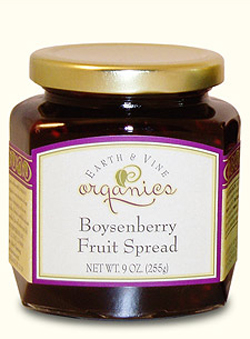
Earth & Vine’s Boysenberry Fruit Spread: “fabulous.” |
Aside from the fact that organically-grown fruit and organically-produced sugar don’t contribute huge amounts of synthetic pesticides to an already overloaded ecosystem, there are advantages to organic preserves, even though they can be pricier. Organic fruit spreads of all kinds are often more expensive, sometimes significantly more expensive, than their traditionally-produced counterparts. But many organic preserves manufacturers are small-scale businesses, the kind I like to support. Quite a number have outstanding products, sometimes in luxurious and creative flavor combinations. Frankly, I find most supermarket brands of conventional preserves pathetic. They’re absurdly sweet, with minimal fruit flavor, and all but a small minority have the cloying aftertaste that results from corn sweeteners. |
Companies
The fruit spreads I tasted include certified organic varieties as well as those that are said to be organic, but are not certified. Some manufacturers use organic fruit but a conventionally-produced sweetener. Sweeteners ranged from fruit juice concentrate to sugar to organic sugar to organic evaporated cane juice (in other words, organic, less-refined sugar).
- For instance, Colorado Mountain Fine Jams and Jellies produces a variety of lovely certified organic jams (their wine jellies will eventually be organic—and certified—but are not currently).
- Chocolatier Lillie Belle Farms makes a few varieties of jams with berries grown on its organically-certified farm. The berries are organic, of course, and they use organic sugar, but the jams themselves have not yet been certified organic, though Lillie Belle is taking steps toward that designation. This is a sideline for Lillie Belle, and their jams are usually available for a few months after harvest season. The Philo Apple Farm in California uses only organically-grown fruit for their preserves, chutneys, etc., although they use conventionally-produced sugar and the preserves themselves are not certified.
- And Mountain Fruit Company, in Chico, California produces an organic Black Mission Fig Spread and an Apricot Fruit Spread with mostly organic ingredients, although I was not able to ascertain whether it is certified organic.
With each company, I list the flavors I tried and my reactions, as well as any manufacturer-specific information. All fruit spreads were tested plain (without bread or 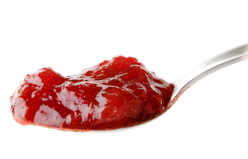 crackers). You probably won’t eat them that way, but they must be able to stand on their own as well as with other foods. I tried no jelly for this report, as jellies are not my favorite among fruit spreads. If a conserve/fruit spread is not listed as “store bought,” it was purchased online. Where a product is noted as “certified organic,” this refers to USDA organic certification unless otherwise specified. Types of sweetener I didn’t understand are listed directly as they appear on product labels and in quotation marks, such as the “organic concentrate fruit juice” of Brad’s Jams (did they mean organic concentrated fruit juice?) and the “organic crystallized cane juice sugar” of Earth & Vine (isn’t crystallized cane juice automatically going to be sugar?). crackers). You probably won’t eat them that way, but they must be able to stand on their own as well as with other foods. I tried no jelly for this report, as jellies are not my favorite among fruit spreads. If a conserve/fruit spread is not listed as “store bought,” it was purchased online. Where a product is noted as “certified organic,” this refers to USDA organic certification unless otherwise specified. Types of sweetener I didn’t understand are listed directly as they appear on product labels and in quotation marks, such as the “organic concentrate fruit juice” of Brad’s Jams (did they mean organic concentrated fruit juice?) and the “organic crystallized cane juice sugar” of Earth & Vine (isn’t crystallized cane juice automatically going to be sugar?).
Seventeen brands were sampled. Of course, based on trying just one or two items from each line it isn’t possible to thoroughly assess any brand, and because different flavors were tasted across lines, these are not meant to be direct comparisons. Nor did I try organic fruit spreads from every company that produces them. Instead, this gives you a little taste, as it were, of what’s available in organic fruit spreads today. Based on our sampling, the brands we’d pursue further include Crofter’s, Earth & Vine Organics, Frog Hollow Farm, Hatch Knoll Farm, High Desert, June Taylor, Marcia’s Chutneys, Northwest Wildfoods and Pastor Chuck.
- Kosher brands include Brad’s, Cascadian Farm, Crofter’s, Dickinson’s and Food For Thought.
- Fair Trade Certified was represented by Food For Thought.
Brands are listed in alphabetical order.
- Bionaturae Organic Wild Berry Fruit Spread. Imported from Italy. Certified organic. Sweetener: organic apple juice concentrate. Berries are bilberries, strawberries, blackberries and raspberries. Some small, very soft berry chunks. Initial berry flavor rapidly turns to a taste of apples, with a strong, “cooked apple” aftertaste. Store bought.
- Brad’s Organic Jams Blueberry Spread. Imported from Italy. Certified organic. Sweetener: “organic concentrate fruit juice.” Lots of blueberries in this spread, though many are on the overly-crunchy side. Initial very strong, unpleasant, acidic taste that eventually fades to a moderate blueberry flavor. Certified kosher by The Organized Kashrus Laboratories. Store bought.
- Cascadian Farm Organic Blackberry Fruit Spread and Organic Strawberry Fruit Spread. Certified organic. Sweetener: organic sugar. A few small, soft chunks of blackberry are in the Blackberry Spread, as well as many seeds! Good blackberry flavor with a lemony-sugar aftertaste. The Strawberry Spread had a moderate strawberry presence, with some chunks of very soft berry, but it was too sweet, with a similar lemony-sugar aftertaste. Cascadian Farm is now owned by General Mills. Certified kosher by Rabbi Moses Londinsky (an independent kosher certifier). Store bought.
- Crofter’s Organic Four Fruit Conserve. Imported from Canada. Certified organic. Sweetener: “organic natural milled
sugar.” Fruits used are
raspberries, strawberries, morello cherries and red currants. Many small chunks of fruit, as well as many seeds. Not too sweet, with good fruit flavors. No one fruit taste stands out; this conserve is a harmonious blend, just as it should be. Certified kosher by The Union of Orthodox Jewish Congregations. Store bought.
|
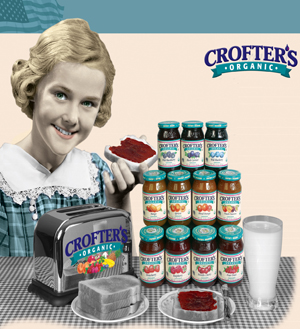
Crofter’s wholesome image also translates into outstanding fruit conserve. |
- Dickinson’s Organic Raspberry Fruit Spread and Organic Blackberry Fruit Spread. Certified organic. Sweetener: organic sugar. The Raspberry Fruit Spread has an initially overwhelming flavor of citric acid and sugar, which turns to a moderate raspberry impact. The Blackberry Fruit Spread has the same excessive initial tastes, but these fade quickly to a strong, tart blackberry presence. Dickinson’s is owned by The J.M. Smucker Company. Certified kosher by the Union of Orthodox Jewish Congregations. Store bought.
- Earth & Vine Organics Boysenberry Fruit Spread and Lemon Cherry Fruit Spread. Although there is no USDA sticker on the label, these products are certified organic through CCOF, California Certified Organic Farmers, a certifying agency for the USDA. Sweetener: “organic crystallized cane juice sugar.” The Boysenberry Fruit Spread is laden with whole berries and berry chunks, with some texture. It’s on the tart side, but not excessively so, and has great fruit flavor. Fabulous! The Lemon Cherry Fruit Spread features whole cherries and cherry chunks in a thickened syrup. There’s a strong lemon presence here, and it’s the first flavor that hits your taste buds, but you taste the cherries, as well. A clever pairing of flavors that works exceptionally well.
- Food for Thought Organic Cherry Raspberry Preserves and Organic Wild Blueberry Merlot Preserves. Certified organic. Sweetener: For Cherry Raspberry variety, organic sugar (also Fair Trade Certified). For Blueberry Merlot variety, organic cane sugar, also listed parenthetically as organic evaporated cane juice. The Cherry Raspberry Preserves are crammed with fruit. They have a thinner consistency than some others. While the raspberries are noticeable as the base of the preserves, the cherries have a greater presence, both in taste and appearance. An unusual but very fine combination. The Wild Blueberry Merlot Preserves are loaded with tiny, wild blueberries, which retain some texture but aren’t the least bit crunchy. I couldn’t detect any merlot taste in these preserves but they’re quite enjoyable nonetheless.
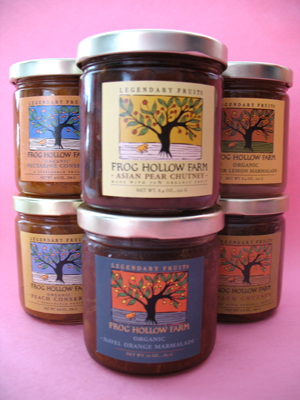
Frog Hollow Farm was a NIBBLE Top Pick Of The
Week.
|
- Frog Hollow Farm Organic Nectarine & Blood Orange Conserve, Organic Cherry Conserve and Organic Apricot Conserve. Certified organic. Sweetener: organic sugar. The Nectarine & Blood Orange Conserve is very similar to a marmalade. It has the piquant flavor of blood oranges but the acidity is smoothed out by the presence of nectarines, and the two fruits go well together. One look at this conserve and you can’t doubt the high fruit content, but that seems to be the case for all fruit spreads made by this company. The Cherry Conserve does not work for me. Its stiff texture simply isn’t spreadable. While it is crammed with whole pitted cherries and cherry chunks, it tastes somewhat overcooked (although that could be just this particular batch).
|
| |
The texture of the cherries is very good, as they aren’t too mushy or too crunchy. The Apricot Conserve has such a vivid orange color that it seems to glow in the jar. It contains very large chunks of apricot but is still spreadable. The apricots retain some texture, and the taste, while not sweet, is exactly what you would want to cheer you up on a grey winter day; it’s the taste of sunshine and summer. No pectin is used in any of these varieties. Three jar minimum order online. (Editor’s Note: Frog Hollow Farm was a Top Pick Of The Week. Read our full review.) |
- Hatch Knoll Farm Organic Raspberry Spread and Organic Wild Maine Blueberry Spread. Certified organic through MOFGA, the Maine Organic Farmers and Gardeners Association. MOFGA is a certifying agency for the USDA, but the
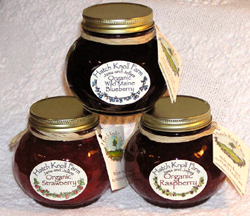 manufacturers have chosen not to place the USDA organic sticker on their labels, which are, according to one proprietor, already “too full of print.” Sweetener: organic cane sugar. The Raspberry Spread has an amazing berry aroma that leaps out of the jar. With a thin consistency despite the use of pectin, this spread resembles a thick purée with seeds. A very strong raspberry flavor and quite tart; if you like your fruit spreads with minimal sugar, this one’s for you. The Blueberry Spread is full of petite, wild blueberries of a true “preserves” consistency, making it easy to spread this product on bread. A terrific blueberry flavor, with just enough sweetness. Wonderful! Order placed through LocalHarvest.org. manufacturers have chosen not to place the USDA organic sticker on their labels, which are, according to one proprietor, already “too full of print.” Sweetener: organic cane sugar. The Raspberry Spread has an amazing berry aroma that leaps out of the jar. With a thin consistency despite the use of pectin, this spread resembles a thick purée with seeds. A very strong raspberry flavor and quite tart; if you like your fruit spreads with minimal sugar, this one’s for you. The Blueberry Spread is full of petite, wild blueberries of a true “preserves” consistency, making it easy to spread this product on bread. A terrific blueberry flavor, with just enough sweetness. Wonderful! Order placed through LocalHarvest.org.
- High Desert Fine Organic Foods Peach Vanilla Bean Confiture, Sweet & Sour Cherry Confiture and Blackberry & Wild Blueberry Confiture. Certified organic. Sweetener: organic sugar. The Peach Vanilla Bean Confiture contains no pectin; it’s a thin syrup with lots of chunks (and smaller pieces) of peach. There’s a very good peach flavor here, and the peach chunks are soft, but not mushy. The Sweet and Sour Cherry Confiture, which does contain pectin, has a thin syrup as a base and is packed full of cherries in two slightly different colors,
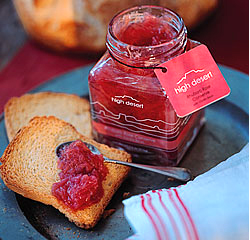 understandably enough. The texture of the cherries is ideal; they’re not crunchy, nor are they falling-apart soft. I enjoyed the true cherry flavor here. Think about this for your favorite good vanilla ice cream, yogurt, or those weekend morning pancakes. The Blackberry and Wild Blueberry Confiture, with no pectin, is another (wait for it!) thin syrup, with masses of berries, again with a great texture. However, the spices in this confiture, which you can smell when you open the jar, overwhelm the berry flavors for me. These confitures tend to be somewhat sweeter than many other organic fruit spreads. Disclosure: The proprietor of High Desert, on hearing why I was ordering, sent along a couple of extra jars. The Sour Cherry Conserve (no pectin), is another thin-syrup-based product with cherries of excellent texture and in large quantity. There is some cherry flavor, but, for my tastes, the spices overwhelm it. The Spiced Peach Conserve (no pectin) contains balsamic vinegar in addition to spices. This is almost the texture of a fruit butter but with many small peach chunks. Again, there is a good peach flavor here, but the spices and balsamic vinegar are slightly too strong for me. understandably enough. The texture of the cherries is ideal; they’re not crunchy, nor are they falling-apart soft. I enjoyed the true cherry flavor here. Think about this for your favorite good vanilla ice cream, yogurt, or those weekend morning pancakes. The Blackberry and Wild Blueberry Confiture, with no pectin, is another (wait for it!) thin syrup, with masses of berries, again with a great texture. However, the spices in this confiture, which you can smell when you open the jar, overwhelm the berry flavors for me. These confitures tend to be somewhat sweeter than many other organic fruit spreads. Disclosure: The proprietor of High Desert, on hearing why I was ordering, sent along a couple of extra jars. The Sour Cherry Conserve (no pectin), is another thin-syrup-based product with cherries of excellent texture and in large quantity. There is some cherry flavor, but, for my tastes, the spices overwhelm it. The Spiced Peach Conserve (no pectin) contains balsamic vinegar in addition to spices. This is almost the texture of a fruit butter but with many small peach chunks. Again, there is a good peach flavor here, but the spices and balsamic vinegar are slightly too strong for me.
- June Taylor Company Aprium Butter, Apricot Conserve, and Rhubarb & Blood Orange Conserve. All fruit used here is grown organically and sustainably, but products are not certified organic. Sweetener: organic sugar. Both the Aprium Butter and Apricot Conserve are of an orange hue deep enough to be mistaken for the setting sun. The Aprium Butter (apriums are a cross
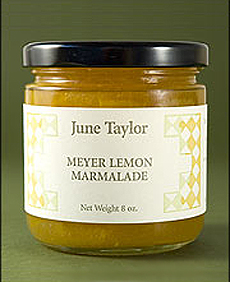 between apricots and plums) has a nicely spreadable texture, almost smooth, with a flavor as intense as its color. The primary taste here is of fruit, not sugar. That holds true for the Apricot Conserve, as well, it’s exactly as though you were eating a fresh apricot, except that the texture is softer. The Apricot Conserve has a somewhat unusual consistency; it’s a cross between a jam and a fruit butter. The texture is almost like a purée, but with many very small pieces of apricot. Both are more than tasty enough to consume from a spoon. The Rhubarb & Blood Orange Conserve is an unappealing shade of brown, but if ever there was a product to prove you shouldn’t judge by appearances, this is it. If I were tasting blindfolded, I’d have been able to tell you there was citrus in here, but that’s about all. Blood orange can be an excessively strong flavor, but here it simply adds sparkle to the rhubarb. A great duo. These products do not contain pectin. Requires a $25 minimum order online, exclusive of shipping charges. between apricots and plums) has a nicely spreadable texture, almost smooth, with a flavor as intense as its color. The primary taste here is of fruit, not sugar. That holds true for the Apricot Conserve, as well, it’s exactly as though you were eating a fresh apricot, except that the texture is softer. The Apricot Conserve has a somewhat unusual consistency; it’s a cross between a jam and a fruit butter. The texture is almost like a purée, but with many very small pieces of apricot. Both are more than tasty enough to consume from a spoon. The Rhubarb & Blood Orange Conserve is an unappealing shade of brown, but if ever there was a product to prove you shouldn’t judge by appearances, this is it. If I were tasting blindfolded, I’d have been able to tell you there was citrus in here, but that’s about all. Blood orange can be an excessively strong flavor, but here it simply adds sparkle to the rhubarb. A great duo. These products do not contain pectin. Requires a $25 minimum order online, exclusive of shipping charges.
- Marcia’s Chutneys Orange Ginger Marmalade, Cranberry Apple Chutney and Green Tomato Chutney. Sweetener: cane sugar. While organic produce and other ingredients are used when possible, the emphasis here is on locally-grown fruits and vegetables. You must call or e-mail Marcia to order, as online ordering is not yet an option and varieties vary seasonally. The Orange Ginger Marmalade, with organic oranges and lemons, is of a genuine “jammy” consistency, with long shreds of orange peel. You’ll note the orange flavor first, then the ginger comes in, along with some taste of lemon. I can see this being an ideal tea-and-toast marmalade, whether you want a gentle awakener at breakfast or something to intrigue your palate at afternoon tea. The Cranberry Apple Chutney (with organic cranberries, apples, and cider vinegar) also has a jam consistency, and it’s thick with chunks of produce. It’s not sweet, but piquant, with a definite tartness. Think leftover turkey sandwiches or pork roast, and you’ve got the idea. The Green Tomato Chutney, with organic green tomatoes, cider vinegar, apples and raisins, has a thinner consistency, though it, too, is filled with raisins and chunks of fruits and veggies. This chutney combines sweetness, spiciness and sharpness, but everything works together, and the result is very good. Neither chutney contains pectin.
- Mediterranean Organic Peach Apricot Preserves. Imported from Italy. Certified organic. Sweetener: organic sugar. A good number of chunks of fruit, ranging in texture from soft to much too crunchy. Decent fruit flavor and not overly-sweet. Store bought.
- Northwest Wildfoods Company, Inc. Hoh River Wild Red Huckleberry Jam, Wild Blue Huckleberry Jam and Wild Mountain Blackberry Jam. Fruit is said to be organic but is not certified. Sweetener: sugar (for this year’s harvest and afterward, the sugar will be organic). All three jams are, well, jam-
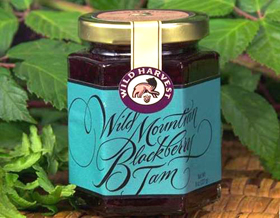 packed with fruit. The Red Huckleberry Jam has a thin consistency. The berries will remind you of cranberries with their intense flavor and degree of tartness. The Blue Huckleberry Jam also has a relatively thin consistency. These berries here are reminiscent of blueberries, but they have a distinctive flavor all their own. The Blackberry Jam has a tart flavor with an undercurrent of both sweetness and lemon. Sugar is used with a judicious hand here, and the emphasis is where it should be: on these special berries. My preferences run toward the Blue Huckleberry or Wild Mountain Blackberry flavors. packed with fruit. The Red Huckleberry Jam has a thin consistency. The berries will remind you of cranberries with their intense flavor and degree of tartness. The Blue Huckleberry Jam also has a relatively thin consistency. These berries here are reminiscent of blueberries, but they have a distinctive flavor all their own. The Blackberry Jam has a tart flavor with an undercurrent of both sweetness and lemon. Sugar is used with a judicious hand here, and the emphasis is where it should be: on these special berries. My preferences run toward the Blue Huckleberry or Wild Mountain Blackberry flavors.
- Pastor Chuck’s Orchards Sweetened Apple Butter. This orchard was started
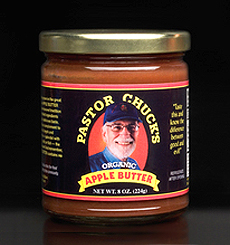 by an Episcopal priest, hence the name. Apple butter and applesauce only, though an apple salsa will be introduced at some point. Organic ingredients, but not certified; according to Pastor Chuck, there is one step in the manufacturing process which is not yet certified organic, but certification is being pursued. Sweetener: organic sugar. A pronounced (but not excessive) spice flavor arrives first, followed by an honest apple taste. Lovely smooth consistency; not too thick or too thin. No pectin. Three jar minimum order online. by an Episcopal priest, hence the name. Apple butter and applesauce only, though an apple salsa will be introduced at some point. Organic ingredients, but not certified; according to Pastor Chuck, there is one step in the manufacturing process which is not yet certified organic, but certification is being pursued. Sweetener: organic sugar. A pronounced (but not excessive) spice flavor arrives first, followed by an honest apple taste. Lovely smooth consistency; not too thick or too thin. No pectin. Three jar minimum order online.
- San Giuliano Marmellata di Mandarini and Marmellata di Agrumi. Imported from Italy. Sweetener: sugar. The A.G. Ferrari website lists both marmalades in their “Organics” section, but neither is USDA certified. The Marmellata di Mandarini is a tangerine marmalade of a “jammy” consistency. Lots of small chunks of fruit and rind with some texture to it. There’s a definite sweet-tart taste here, and no one can doubt that this preserve is citrus-based. I’d think the strong flavor here could stand up to a hearty whole grain bread. The Marmellata di Agrumi is made with Sicilian orange, lemon and grapefruit rind. It has a somewhat thinner consistency than the Marmellata di Mandarini. The Marmellata di Agrumi also has a flavor I don’t care for. It’s “brighter” than the Mandarini, but there’s a very strong, very bitter citrus taste in the midst of it all. This marmalade is also filled with many small chunks of fruit rind. Neither of these contains pectin.
- Vita Real Organic Strawberry Extra Fruit Jam, no website. Imported from Italy. Certified organic. Sweetener: organic brown sugar. A true “jammy” purée, with very modest strawberry flavor. Not too sweet. Not inspiring. Store bought (at a Whole Foods Market).
Sources and Acknowledgements:
Prices and flavor availability are verified at publication but are subject to change. Shipping is additional.

|






 manufacturers are proud of the flavor of their fruit (which is often organically grown) and prefer to let that taste be the predominant one, so they use less sugar than what is required by the FDA (I have not yet run across a manufacturer of organic fruit spreads who uses corn sweeteners, and I’d like that trend to continue). Therefore, they’re not allowed to call their product either. For this reason, you’ll often see organic preserves labeled as “fruit spreads” or “conserves.” These products don’t necessarily adhere to the traditional definition of either fruit spreads or conserves, but their manufacturers have to find a name for the product that most people will recognize and that conveys some sense of what the product is. Some organic preserves also lack pectin, which means they may have a thinner consistency than those you’re accustomed to (depending upon the fruit[s] used); you must judge whether or not you find that acceptable.
manufacturers are proud of the flavor of their fruit (which is often organically grown) and prefer to let that taste be the predominant one, so they use less sugar than what is required by the FDA (I have not yet run across a manufacturer of organic fruit spreads who uses corn sweeteners, and I’d like that trend to continue). Therefore, they’re not allowed to call their product either. For this reason, you’ll often see organic preserves labeled as “fruit spreads” or “conserves.” These products don’t necessarily adhere to the traditional definition of either fruit spreads or conserves, but their manufacturers have to find a name for the product that most people will recognize and that conveys some sense of what the product is. Some organic preserves also lack pectin, which means they may have a thinner consistency than those you’re accustomed to (depending upon the fruit[s] used); you must judge whether or not you find that acceptable. 
 crackers). You probably won’t eat them that way, but they must be able to stand on their own as well as with other foods. I tried no jelly for this report, as jellies are not my favorite among fruit spreads. If a conserve/fruit spread is not listed as “store bought,” it was purchased online. Where a product is noted as “certified organic,” this refers to USDA organic certification unless otherwise specified. Types of sweetener I didn’t understand are listed directly as they appear on product labels and in quotation marks, such as the “organic concentrate fruit juice” of Brad’s Jams (did they mean organic concentrated fruit juice?) and the “organic crystallized cane juice sugar” of Earth & Vine (isn’t crystallized cane juice automatically going to be sugar?).
crackers). You probably won’t eat them that way, but they must be able to stand on their own as well as with other foods. I tried no jelly for this report, as jellies are not my favorite among fruit spreads. If a conserve/fruit spread is not listed as “store bought,” it was purchased online. Where a product is noted as “certified organic,” this refers to USDA organic certification unless otherwise specified. Types of sweetener I didn’t understand are listed directly as they appear on product labels and in quotation marks, such as the “organic concentrate fruit juice” of Brad’s Jams (did they mean organic concentrated fruit juice?) and the “organic crystallized cane juice sugar” of Earth & Vine (isn’t crystallized cane juice automatically going to be sugar?). 

 understandably enough. The texture of the cherries is ideal; they’re not crunchy, nor are they falling-apart soft. I enjoyed the true cherry flavor here. Think about this for your favorite good vanilla ice cream, yogurt, or those weekend morning pancakes. The Blackberry and Wild Blueberry Confiture, with no pectin, is another (wait for it!) thin syrup, with masses of berries, again with a great texture. However, the spices in this confiture, which you can smell when you open the jar, overwhelm the berry flavors for me. These confitures tend to be somewhat sweeter than many other organic fruit spreads. Disclosure: The proprietor of High Desert, on hearing why I was ordering, sent along a couple of extra jars. The Sour Cherry Conserve (no pectin), is another thin-syrup-based product with cherries of excellent texture and in large quantity. There is some cherry flavor, but, for my tastes, the spices overwhelm it. The Spiced Peach Conserve (no pectin) contains balsamic vinegar in addition to spices. This is almost the texture of a fruit butter but with many small peach chunks. Again, there is a good peach flavor here, but the spices and balsamic vinegar are slightly too strong for me.
understandably enough. The texture of the cherries is ideal; they’re not crunchy, nor are they falling-apart soft. I enjoyed the true cherry flavor here. Think about this for your favorite good vanilla ice cream, yogurt, or those weekend morning pancakes. The Blackberry and Wild Blueberry Confiture, with no pectin, is another (wait for it!) thin syrup, with masses of berries, again with a great texture. However, the spices in this confiture, which you can smell when you open the jar, overwhelm the berry flavors for me. These confitures tend to be somewhat sweeter than many other organic fruit spreads. Disclosure: The proprietor of High Desert, on hearing why I was ordering, sent along a couple of extra jars. The Sour Cherry Conserve (no pectin), is another thin-syrup-based product with cherries of excellent texture and in large quantity. There is some cherry flavor, but, for my tastes, the spices overwhelm it. The Spiced Peach Conserve (no pectin) contains balsamic vinegar in addition to spices. This is almost the texture of a fruit butter but with many small peach chunks. Again, there is a good peach flavor here, but the spices and balsamic vinegar are slightly too strong for me.  between apricots and plums) has a nicely spreadable texture, almost smooth, with a flavor as intense as its color. The primary taste here is of fruit, not sugar. That holds true for the Apricot Conserve, as well, it’s exactly as though you were eating a fresh apricot, except that the texture is softer. The Apricot Conserve has a somewhat unusual consistency; it’s a cross between a jam and a fruit butter. The texture is almost like a purée, but with many very small pieces of apricot. Both are more than tasty enough to consume from a spoon. The Rhubarb & Blood Orange Conserve is an unappealing shade of brown, but if ever there was a product to prove you shouldn’t judge by appearances, this is it. If I were tasting blindfolded, I’d have been able to tell you there was citrus in here, but that’s about all. Blood orange can be an excessively strong flavor, but here it simply adds sparkle to the rhubarb. A great duo. These products do not contain pectin. Requires a $25 minimum order online, exclusive of shipping charges.
between apricots and plums) has a nicely spreadable texture, almost smooth, with a flavor as intense as its color. The primary taste here is of fruit, not sugar. That holds true for the Apricot Conserve, as well, it’s exactly as though you were eating a fresh apricot, except that the texture is softer. The Apricot Conserve has a somewhat unusual consistency; it’s a cross between a jam and a fruit butter. The texture is almost like a purée, but with many very small pieces of apricot. Both are more than tasty enough to consume from a spoon. The Rhubarb & Blood Orange Conserve is an unappealing shade of brown, but if ever there was a product to prove you shouldn’t judge by appearances, this is it. If I were tasting blindfolded, I’d have been able to tell you there was citrus in here, but that’s about all. Blood orange can be an excessively strong flavor, but here it simply adds sparkle to the rhubarb. A great duo. These products do not contain pectin. Requires a $25 minimum order online, exclusive of shipping charges.  packed with fruit. The Red Huckleberry Jam has a thin consistency. The berries will remind you of cranberries with their intense flavor and degree of tartness. The Blue Huckleberry Jam also has a relatively thin consistency. These berries here are reminiscent of blueberries, but they have a distinctive flavor all their own. The Blackberry Jam has a tart flavor with an undercurrent of both sweetness and lemon. Sugar is used with a judicious hand here, and the emphasis is where it should be: on these special berries. My preferences run toward the Blue Huckleberry or Wild Mountain Blackberry flavors.
packed with fruit. The Red Huckleberry Jam has a thin consistency. The berries will remind you of cranberries with their intense flavor and degree of tartness. The Blue Huckleberry Jam also has a relatively thin consistency. These berries here are reminiscent of blueberries, but they have a distinctive flavor all their own. The Blackberry Jam has a tart flavor with an undercurrent of both sweetness and lemon. Sugar is used with a judicious hand here, and the emphasis is where it should be: on these special berries. My preferences run toward the Blue Huckleberry or Wild Mountain Blackberry flavors.  by an Episcopal priest, hence the name. Apple butter and applesauce only, though an apple salsa will be introduced at some point. Organic ingredients, but not certified; according to Pastor Chuck, there is one step in the manufacturing process which is not yet certified organic, but certification is being pursued. Sweetener: organic sugar. A pronounced (but not excessive) spice flavor arrives first, followed by an honest apple taste. Lovely smooth consistency; not too thick or too thin. No pectin. Three jar minimum order online.
by an Episcopal priest, hence the name. Apple butter and applesauce only, though an apple salsa will be introduced at some point. Organic ingredients, but not certified; according to Pastor Chuck, there is one step in the manufacturing process which is not yet certified organic, but certification is being pursued. Sweetener: organic sugar. A pronounced (but not excessive) spice flavor arrives first, followed by an honest apple taste. Lovely smooth consistency; not too thick or too thin. No pectin. Three jar minimum order online.